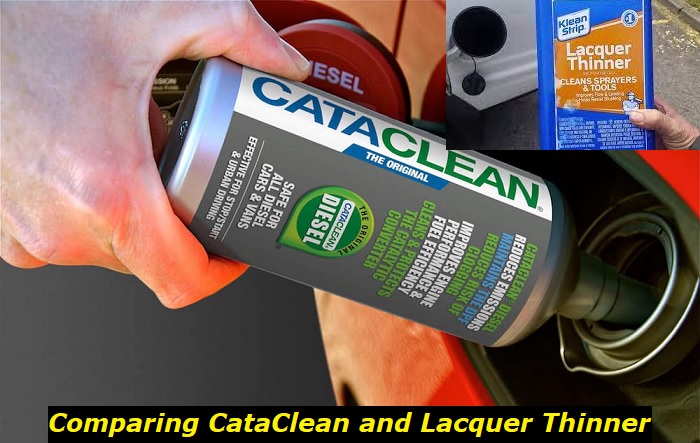Your catalytic converter is one of the most important parts when it comes to controlling overall exhaust emissions. Be that as it may, over time the cats can accumulate dirt and become clogged, negatively impacting engine efficiency and increasing harmful emissions to the point where it can even damage your car.
Catalytic converter cleaning additives highlights
- Efficiency:close to zero
- Availability:limited number of products
- Average price: $80
- Way to use:spray into the throttle
- DIY use:yes, butmaybe complicated
- Experts' advice:no positive advice
- Independent testing:negative testing results
- Consequences:damage to a lot of expensive components, no effect on catalytic converter

Cataclean vs Lacquer Thinner: Cleaning Your Cat Converter
Cataclean is a well-known fuel additive intended to clean your cats from the factory while lacquer thinner is designed for dissolving and stripping lacquer-based paint.
As such, using lacquer thinner is not recommended as it can even damage the insides of your cats or other parts of your emissions control systems while also badly affecting your performance, fuel efficiency, and emissions.
Today we will talk about:
- Is Cataclean Good for Catalytic Converter Cleaning?
- How to Use Cataclean?
- Should I Use Lacquer Thinner to Clean My Catalytic Converter?
- How to Maintain a Catalytic Converter?
- Can I Drive Without a Catalytic Converter?
- How Much is a New Catalytic Converter?
Is Cataclean Good for Catalytic Converter Cleaning?
Cataclean is a fuel additive mixture of various chemicals and detergents designed to clean your catalytic converter. It is designed and made specifically for cleaning the catalytic converter which means that it is a good fit for such a purpose.
Catclean aims to reduce overall carbon deposits on the inside of your cats while also getting rid of unburned fuel residues. However, you do need to keep in mind that Cataclean is not designed to work with a blocked converter. As such, if your cats are severely clogged or malfunctioning, the best course of action would be to ask for professional help.
If used for what it's intended to do and if used according to the instructions, Cataclean is indeed a viable solution for catalytic converter cleaning.
How to Use Cataclean?
If you plan on using Cataclean, be sure to follow these steps carefully:
- Read the Label - There are different types of Cataclean solutions for diesel and gasoline engines so be sure to get the proper solution before trying to use it.
- Add Cataclean to Your Tank - Be sure to pour Cataclean into your vehicle's fuel tank directly, either while filling up your tank or separately. However, it's best to use Cataclean while low on fuel as that ensures better mixing.
- Fuel Up - Next up, you should fuel up your car to at least half a tank as you want Cataclean to mix with your fuel as best as possible.
- Drive - Start your car up and drive for at least 15 to 30 minutes as that allows Cataclean to properly circulate the fuel system, the combustion chamber, your fuel lines, and the converter itself. It's best to do this while finishing your daily commute.
- Park the Car Up - The reason why it's best to add Cataclean while finishing your commute as you want the car to sit for a few hours in order for Cataclean to clean your cats more effectively. Leaving your car overnight should be more than enough time.
Should I Use Lacquer Thinner to Clean My Catalytic Converter?
Even though some people believe lacquer thinner is a perfect catalytic converter cleaning life hack, the truth is that it actually isn't, far from it to be exact.
Lacquer thinner is a very powerful solvent designed to dissolve and remove strong adhesives, paint, and even varnishes. Therefore, it's not a good idea to use it as it can damage essential parts of your fuel system. Lacquer thinner can clean your catalytic converter, but it can often cause more harm than good.
Overall, trying to use unproven and not recommended solutions for maintaining your car is a big no-go as it can also void your warranty.
How to Maintain a Catalytic Converter? Tips and Tricks
1) Use High-Quality Fuel
The idea here is to always use high-quality gasoline from proven and reputable sources. Low-quality and contaminated fuel is known to increase carbon deposits and potentially even damage your catalytic converter over time.
Moreover, it can also clog your cats over time which can affect your emissions, and your performance, potentially even resulting in a failed catalytic converter.
2) Go Easy With Your Driving Habits
The way you drive your car can have a massive impact on how reliable it becomes. If you avoid aggressive driving, excessive idling, and aggressive accelerations, your powertrain is going to thank you, and consequently your catalytic converter.
If you do drive aggressively, you are going to experience higher overall temperatures in your catalytic converter which can affect its ability to control your emissions. Furthermore, rapid accelerations can aid in catalytic converter clogging more quickly than otherwise.
3) Regular Car Maintenance
If you take care of your vehicle, your vehicle is going to take care of you. As such, if you perform regular oil changes, filter changes, air filter changes, and spark plug changes, you are going to keep your exhaust and fuel system in perfect working order.
All of this is going to benefit your catalytic converter as it is going to be under a much lower stress level as opposed to when it's connected to a poorly maintained fuel and exhaust system.
4) Address Issues Promptly
Doing all the repairs in time is equally as important as properly maintaining your car. So, if your engine and other parts of the powertrain start experiencing problems, be sure to address them immediately as that is going to affect your catalytic converter when it comes time to take care of the emissions.
5) Perform Regular Emissions Tests
The only true way of knowing if your catalytic convert is able to maintain a proper level of exhaust emissions is to perform regular emissions tests. Since these are mandatory in most states, be sure to perform them whenever needed and do not skip them.
6) Inspect your Exhaust System
Your exhaust system is directly linked to the catalytic converter which means that a healthy exhaust system means a healthy catalytic converter, and vice versa. Therefore, check the exhaust for leaks, keep it clean, and do your best to avoid corrosion.
All of these can negatively affect the catalytic converter, especially a leak as it can create an opening for dirt and debris to get inside. If that does happen, it is inevitably going to leak into a clogged catalytic converter.
How Much is a New Catalytic Converter?
The costs of a new catalytic converter can vary greatly, mostly depending on the type of car and its powertrain. For example, most "standard" aftermarket catalytic converters costs between $100 and $400.
On the other hand, a higher-performance catalytic converter should set you back around $400 to $2000 or even more for limited-production exotic performance cars. Acquiring one used is also a good idea, but there is rarely such a thing as a cheap catalytic converter, no matter the state it's in.
An original OEM catalytic converter tends to be more expensive than a standard aftermarket one, so be sure to pay more than $500 for most. We also need to state that some cars have multiple catalytic converters which brings the price up even more.
Lastly, it's always better to pay a bit extra and go for a brand new catalytic converter compared to going with a used one. It's very difficult to know if a used catalytic converter has been cleaned or repaired if you are not an experienced mechanic.
Can I Drive Without a Catalytic Converter?
Technically, you can drive without a catalytic converter but that does not mean that you should. Even though many people purposely take off the cats in order to make their cars louder and more powerful, removing them is often illegal and punishable by law.
If you decide to drive without a converter, you are going to experience increased emissions, reduced fuel efficiency, a check engine light, and various performance issues. Moreover, you are going to void your warranty and maybe even cause irreparable damage to your exhaust system such as excessive corrosion.
Conclusion
When it comes to cleaning your catalytic converter, it's best to use a dedicated catalytic converter cleaner, one that is purposely designed for your car. There is an ongoing discussion online about whether Cetaclean or lacquer thinner is better for cleaning the catalytic converter, and the answer to this question is simple - Cataclean is better.
There are a few reasons why, it's actually designed to clean the cats, it isn't as harmful, and it isn't as harmful to the environment. There is no need to reinvent the wheel here as you should always use these for what they are intended.
About the authors
The CarAraC research team is composed of seasoned auto mechanics and automotive industry professionals, including individuals with advanced degrees and certifications in their field. Our team members boast prestigious credentials, reflecting their extensive knowledge and skills. These qualifications include: IMI: Institute of the Motor Industry, ASE-Certified Master Automobile Technicians; Coventry University, Graduate of MA in Automotive Journalism; Politecnico di Torino, Italy, MS Automotive Engineering; Ss. Cyril and Methodius University in Skopje, Mechanical University in Skopje; TOC Automotive College; DHA Suffa University, Department of Mechanical Engineering






Add comment